Preboarding Employees: The Ultimate Guide for HR

Preboarding employees helps new hires feel welcomed and prepared before their first day. When done correctly, it reduces stress, speeds up adaptation, and increases retention. In this guide, we’ll break down what preboarding is, how it differs from onboarding, and how to implement it efficiently – without unnecessary bureaucracy.
What Is Preboarding?
Preboarding is the period between a candidate accepting a job offer and their first day. It basically starts before the employee’s official start date. It’s the first step in the employee’s journey, designed to make the transition smooth and effective. Many confuse preboarding with onboarding, but they are different.
Preboarding vs. onboarding
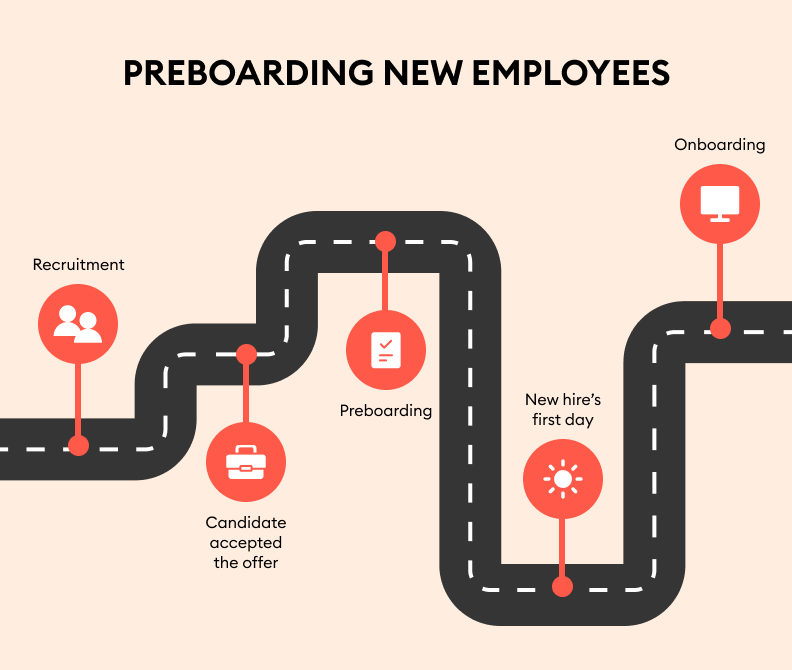
The onboarding process starts when a new employee arrives for their first day and continues through their first weeks or months. It includes:
- Filling out tax forms and setting up payroll
- Reviewing the employee handbook
- Getting access to work tools (email, badges, accounts)
- Learning company policies, security rules, and compliance
- Meeting future colleagues and managers
- Completing role-specific training
Most of these tasks don’t need to occur in the office. That’s where preboarding comes in.
Why Is It Important for HR to Conduct Preboarding?
According to research, 30% of new hires leave within the first 90 days. A strong preboarding process helps build trust and ensures a smoother transition before their first day. During this stage, new employees complete administrative tasks in advance, freeing their first day for meaningful interactions.
Preboarding essentials might include:
- Signing an employment contract and NDA (non-disclosure agreement) and providing emergency contacts.
- Access to onboarding software and internal systems.
- A welcome email with key company values.
- Compliance training prior to day one.
- A personal note from the hiring manager or a team introduction.
This approach ensures that new team members feel engaged, reducing new hire turnover and improving overall satisfaction. A great preboarding experience creates a strong foundation for the onboarding process.
Benefits of Preboarding
A well-structured preboarding process boosts employee engagement, reduces new hire turnover, and improves first-day experiences. Here’s how it works:
Higher engagement and commitment
Preboarding strengthens the connection between new hires and current employees before day one. By introducing company culture, personalizing communication, and inviting new hires to company events, the organization creates a welcoming environment.
Lower employee turnover
Early-stage turnover is a real problem. Some industries see new hire churn rates as high as 500% per year. A structured preboarding strategy builds connection and trust, reducing the risk of candidates ghosting you before they even start. This is especially valuable in freelance and contract work, where loyalty is often low.
A smooth first-day experience
The first day shouldn’t be about signing forms and struggling with office logistics. Instead, it should focus on meeting the team, understanding company culture, and getting excited about the job. A solid preboarding process takes care of admin issues in advance so new hires can focus on what matters: learning, integrating, and contributing.
Less first-day anxiety
Uncertainty generates stress. A well-designed preboarding experience answers questions early. Whether through an employee welcome kit, an FAQ email, or an online session, preboarding ensures that new hires start with confidence, not confusion.
Faster productivity from day one
When new hires spend their first days on admin tasks, they’re not working. A streamlined preboarding process handles paperwork and system setups before day one so employees can dive into meaningful tasks sooner. Preboarding training – such as company orientation or compliance modules – further accelerates their ramp-up time.
A Practical Guide to the Online Preboarding Process
Preboarding isn’t just about making new hires feel welcome – it impacts business outcomes directly. Here’s how to build a structured online preboarding program that engages employees before their first day.
Step 1: Create a preboarding checklist
Before launching your program, list all tasks that need to be completed. A structured preboarding checklist ensures that no crucial steps are missed. Here are the key items to include:
- Setting up IT accounts and email access
- Sending out welcome emails and necessary paperwork
- Assigning a mentor or onboarding buddy
- Sharing access to training materials and company policies
Step 2: Assign a buddy before day one
Pair new hires with a buddy, an experienced team member – someone they’ll work closely with. Usually, buddy programs start during onboarding, but moving this step to preboarding helps reduce first-day stress.
- Introduce the new hire to their buddy via chat or video call.
- Encourage open communication to address questions early.
- Set up a dedicated communication channel for quick support.
Step 3: Announce the new hire to the team
A warm company-wide introduction helps new hires feel included before they even start. Choose the best platform for your culture – email, Slack, Microsoft Teams, or an internal forum.
Your message should include:
- The new hire’s name, role, and start date.
- A brief background text on their experience.
- A fun fact or reason they stood out in the hiring process.
- Links to their LinkedIn profile (if appropriate) for networking.
Step 4: Keep in touch before their start date
For some hires, preboarding lasts a few days; for others, it may be weeks or months. Long gaps increase the risk of disengagement or job offer ghosting. Prevent this by staying in touch:
- Send company updates, videos, or newsletters.
- Offer to answer questions before their first day.
- Remind them about key resources they can review in advance.
Step 5: Share the employee handbook and benefits package
Give new hires access to essential documents before day one. This includes the company handbook, benefits guide, and workplace policies. That way, they’ll start prepared with an understanding of:
- Company culture and values.
- Perks and benefits (healthcare, retirement plans, paid time off).
- Workplace policies on communication, dress code, remote work, etc.
Step 6: Provide online preboarding training
A self-paced online preboarding course reduces manual work for HR and speeds up the onboarding process. It helps employees familiarize themselves with:
- Compliance training and workplace ethics.
- Internal tools, software, and communication platforms.
- Company goals, structure, and the leadership team.
How to Build an Effective Online Preboarding Program
An asynchronous preboarding course helps new hires get up to speed before their first day. It’s on-demand, reusable, and scalable – train employees once, and use the course for years.
To create a structured preboarding experience, follow these three steps:
Step 1: Design the preboarding course
Your preboarding training should focus on two key areas:
- Welcome training. This introduces new hires to company culture, values, leadership, and key policies. A well-structured preboarding course ensures that employees feel aligned with the organization’s mission before they even start. When new hires understand what the company stands for and how they fit in, they gain confidence, feel more engaged, and integrate faster.
Employees who feel welcomed and informed are more likely to build strong relationships, collaborate effectively, and contribute meaningfully from day one.
Here is a sample preboarding course structure:
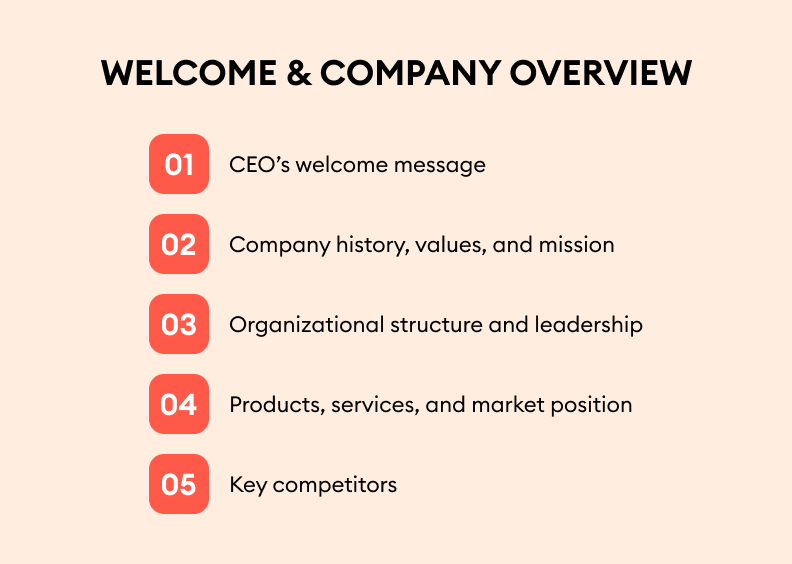
- Compliance training. This training is crucial for preventing legal risks, maintaining a safe work environment, and establishing clear expectations from the start.
When new hires are familiar with compliance requirements before their first day, they can focus on their role without confusion or delays. It also reinforces a culture of responsibility and integrity, helping employees feel more confident navigating company policies. A well-prepared workforce leads to fewer compliance issues and a smoother integration into daily operations.
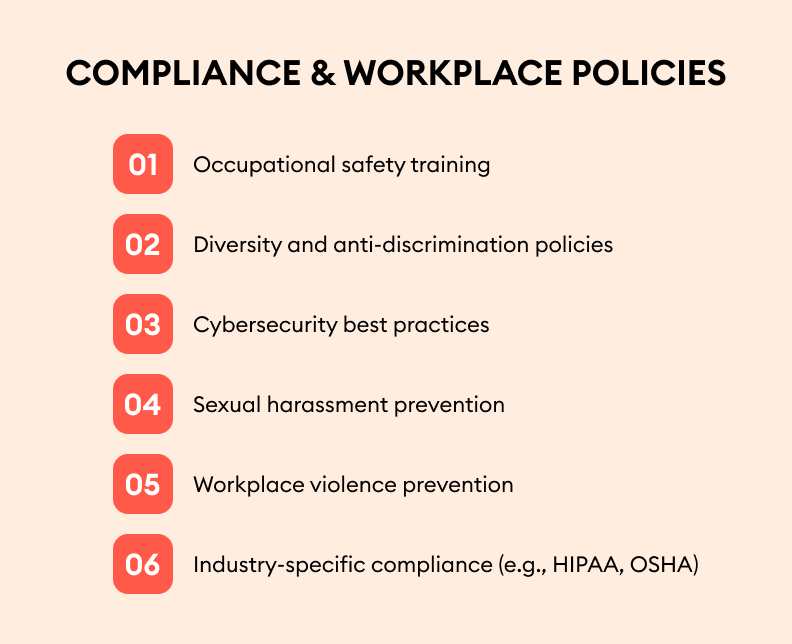
With a structured preboarding induction, new hires settle in faster. They learn the basics before day one, so onboarding takes less time, and compliance issues are less likely.
Step 2: Create engaging learning materials
If you’re new to course authoring and online training, building a structured preboarding program might seem complex. The good news? You don’t need coding skills or an instructional design background – modern eLearning tools make it easy.
Let’s take iSpring Suite as an example. This powerful yet user-friendly authoring tool allows you to develop a complete preboarding experience with interactive and multimedia-rich content. Here’s what you can make with iSpring Suite directly in PowerPoint:
Interactive slide-based courses. Easily transform PowerPoint presentations into dynamic eLearning courses. Add:
- Clickable elements for self-paced learning.
- Animations and transitions to keep content engaging.
- Navigation controls to ensure a structured learning flow.
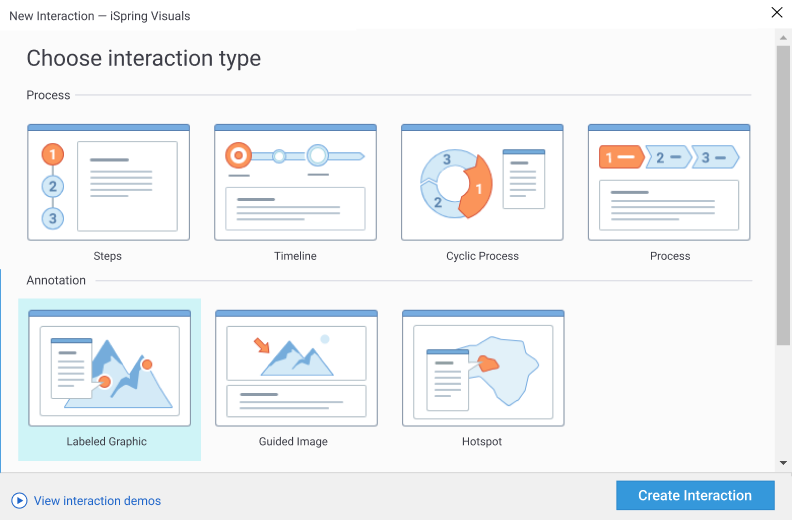
Video and Screencasts. This is an excellent way to introduce new hires to the company culture. With iSpring Suite, you can:
- Record welcome messages from leadership.
- Capture software tutorials for onboarding tools.
- Add voice-overs, captions, and effects to enhance comprehension.

Role-play simulations for real-world scenarios. Help new employees navigate common workplace situations with interactive conversation simulations. iSpring Suite allows you to:
- Create branching scenarios that change based on responses.
- Simulate customer interactions, HR discussions, or ethical dilemmas.
- Offer real-time feedback to reinforce best practices.

Quizzes and knowledge checks. Preboarding isn’t just about delivering information – it’s designed to ensure that new hires understand key policies and company values. With iSpring’s built-in quiz maker, you can:
- Create drag-and-drop, multiple-choice, and other types of questions.
- Set pass/fail thresholds to track completion and compliance.
- Provide instant feedback to reinforce learning.
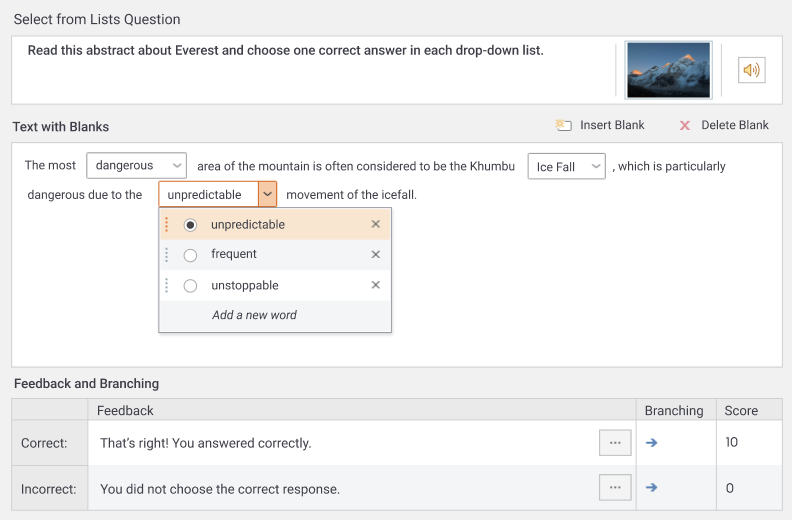
Microlearning modules for on-the-go training. Not all new hires have time for lengthy courses. With iSpring Suite, you can create bite-sized, mobile-friendly training that:
- Covers one key topic at a time.
- Features interactive elements to boost retention.
- Works seamlessly on smartphones and tablets.
All these features are available within a single interface, making it easy to create, edit, and deploy courses at scale.
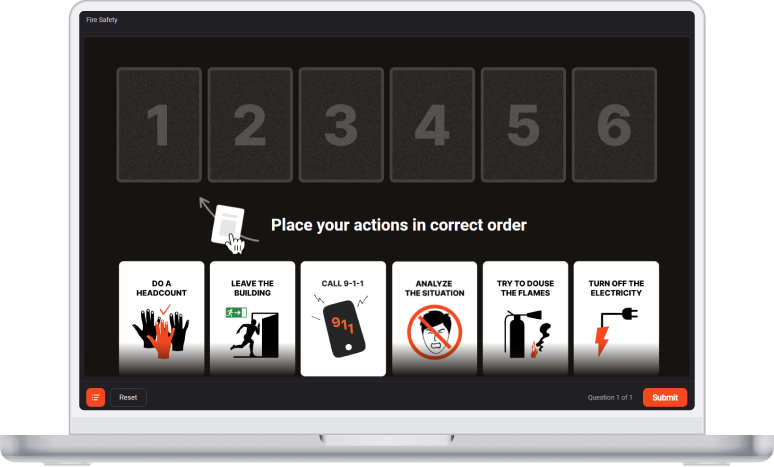
Step 3. Deliver preboarding content to new hires
A preboarding course is useless if no one sees it. The best way to deliver training is through a Learning Management System (LMS). An LMS automates routine tasks like sending invites, assigning courses, and tracking progress.
If your company doesn’t use an LMS, try iSpring Learn. It helps HR teams set up structured learning paths and assign courses in just a few clicks. The platform also provides mobile access via a dedicated app, allowing new hires to complete training anytime, anywhere – even offline.
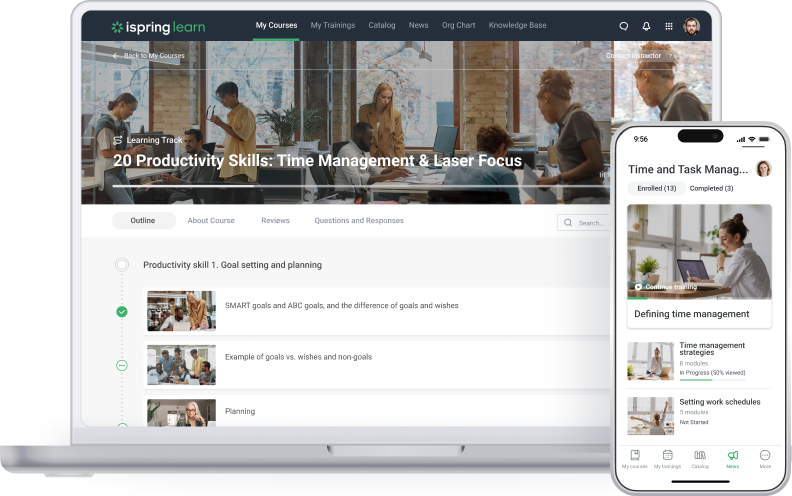
Why is an LMS essential for preboarding?
- Automates admin work – no need to manually send materials or track completion. The system does it for you.
- Works across devices – employees can train on laptops, smartphones, or tablets.
- Provides learning analytics – tracks progress, provides quiz results, and identifies gaps in real time.
- Scales with your company – allows you to easily add new hires and update training materials as needed.
Read also: The Best HR Tools for Streamlining Your Workflow
Essential preboarding tasks
Preboarding isn’t just about training – it’s about reducing uncertainty and making the first day smooth. Here’s what to do before a new hire starts:
Provide access to work tools. Set up corporate email and logins for internal systems, CRM, and project management tools. Send credentials in advance so the employee can log in on day one.
Send a first-day email. New hires feel lost on their first day. Help them. Send an email with:
- A checklist for the first day (what to do, where to go, who to meet).
- Technology setup instructions (how to log in to key systems).
- Calendar invites to onboarding sessions, intro meetings, and team calls.
Provide an FAQ. New employees have the same questions:
- What time should I start work?
- Where do I find internal documents?
- Who do I contact if I have an issue?
Bonus: Add an interactive FAQ using iSpring Suite. Employees can click through real-world scenarios, find answers, and get comfortable with company processes before their first day.
Next step: How to Train New Employees Effectively
Key components of an effective preboarding process
A well-designed preboarding process fosters engagement, excitement, and clarity. To set employees up for success:
- Provide clear communication – Outline what to expect before their first day.
- Make it interactive – Include videos, quizzes, or virtual meet-and-greets.
- Ensure IT readiness – Make sure logins and devices are set up in advance.
- Share the company culture – Send stories, testimonials, or insights from colleagues.
- Encourage early connections – Pair new hires with buddies or mentors before they start.
When employees feel supported from the start, they are more likely to be engaged and productive in their new roles.
Measuring Preboarding Success
Tracking key metrics ensures continuous improvement in the preboarding experience. Effective measurement strategies include:
- New hire surveys to gather direct feedback on the preboarding process.
- Retention rates within the first six months to assess long-term impact.
- Time-to-productivity assessments to determine how quickly new hires adapt.
- Engagement levels in preboarding activities, such as training or team introductions.
- Manager feedback on employee preparedness before the first day.
Final Thoughts
Preboarding isn’t just a formality – it’s a key step in employee retention. A well-structured process reduces first-day stress, boosts engagement, and helps new hires adapt faster. Just a few thoughtful actions can turn a chaotic first day into a smooth, productive start.
Make preboarding a priority, and you’ll see the impact: confident employees, stronger commitment, and a seamless transition into the team.
If you haven’t implemented a preboarding program yet, book a free demo of iSpring Learn with one of iSpring’s eLearning experts and get all the insights you need to launch online training easily.







